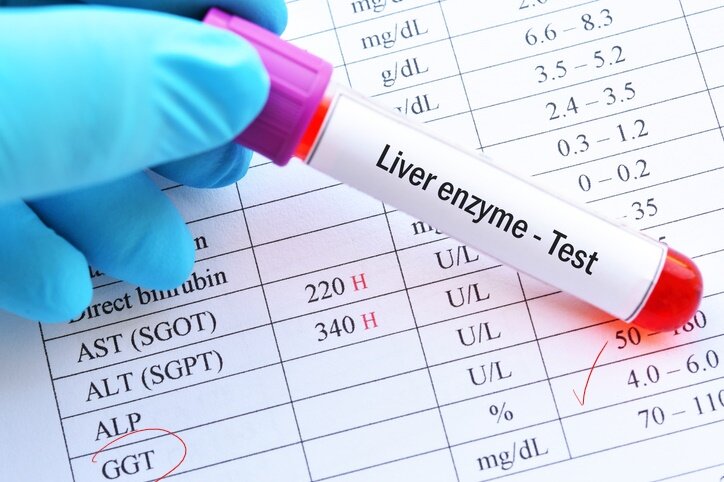GGT: The Most Important Predictor of Disease and Mortality
I am sure most of you have never heard of GGT. It is not your fault; it is not considered to be as important as a marker for disease as others, such as cholesterol by most medical practitioners. As you will find out today, it may be the single most important predictor of disease medicine has today.
What is GGT?
GGT is short for Gamma-Glutamyltransferase and alternatively Gamma-Glutamyltranspeptidase. It is an enzyme found in the liver routinely tested for on standard blood tests under the section for liver function. Traditionally, increased levels served as a marker of liver dysfunction, bile duct conditions, and alcohol consumption. Still, it goes well beyond that as an indicator of potential disease, including cardiovascular disease, diabetes, metabolic syndrome (MetS), and all-cause mortality. (1)
How Does GGT Work?
The liver's job is to detoxify the body, and GGT is critical to the final step in the process. It is the final chemical modifier necessary to eliminate many harmful substances properly. The liver uses three distinct phases to eliminate toxins. Phase I is similar to placing waste in the household garbage receptacle. Phase II is just like taking the rubbish outside to await curbside pickup. Finally, phase III is precisely like the refuse hauler taking the waste away from your property for disposal. Defects in any phase will result in the accumulation of toxins, which is a bad thing. With excessive toxin load, GGT increases to maintain proper elimination; hence, elevated GGT indicates an increased burden of toxin elimination.
What is the Normal GGT Level?
Most tests use 60 or 65 IU/L as the upper limit of normal, which means anything above is considered an indication of potential trouble. Based on the currently available research, the functional medicine limits are quite a bit lower, with the limit being 29 IU/L for males and 21 IU/L for females. For more information on why the limit is so much lower for functional medicine, read this previous post.
The Geeky Science of GGT and Disease
The primary function of GGT is enabling the metabolism of glutathione and glutathionylated xenobiotics. In simpler terms, glutathione is the most critical antioxidant in the body. Once it has neutralized a toxin, it is modified by GGT for excretion by the kidneys. Paradoxically, science has shown excess GGT to promote oxidation in the presence of iron and copper. (2) The oxidative stress caused by GGT initiates a chain reaction leading to the downstream cell, tissue, and DNA damage. All are associated with atherosclerosis, heart failure, arterial stiffness and plaque, gestational diabetes, and various liver diseases, including viral hepatitis, other infectious diseases, and several life-threatening cancers. (3) Elevated GGT is present in patients with periodontal disease as well. (4)
GGT and Mortality Prediction
Kazemi-Shirazi and others found high GGT increased the potential 30% for cancer mortality, 60% for both vascular mortality and death due to ischemic heart disease, and 40% for stroke deaths. The participants under thirty years of age showed the highest correlation, meaning that high GGT is an early indicator of trouble. (5)
GGT: The Crystal Ball for Metabolic Syndrome
The definition of Metabolic syndrome (MetS) includes the presence of hypertension, high blood sugar, high cholesterol, and high BMI. After an eight-year study, Lee et al. reported in 2007 that baseline measures of GGT were significantly related to the onset of MetS. They found that participants with the highest GGT levels experienced a 67% increase in heart disease incidence. (6) In 2010, Dhingra et al. uncovered a similar relationship with GGT-related heart failure outcomes. A few more studies have demonstrated the predictive marker for heart disease and heart failure many years before their onset. (7)
Early Detection of High GGT Correlates with Cancer
Strasak found that after two studies of 12.5 and 13.5 years, high GGT was most predictive for cancers of the esophagus, larynx, stomach, colon, bile duct, and lung. The correlation was strongest, especially when tested before age 65. (8)
GGT, and Iron
High GGT causes tissue and cell damage, and Red blood cells (RBS's) are particularly susceptible. Damaged RBC's lead to iron release, which is hugely damaging. (5) You can read more about the subject in my previous post As a result of this relationship, GGT is a marker of toxic iron levels. Interestingly, high iron is also a predictor of metabolic syndrome. (9)
GGT and Poisons
Lee and Jacobs described the association of GGT levels to what they referred to as persistent organic pollutants (POPs). As I stated earlier, more GGT is needed to detoxify in the presence of excessive toxins. High GGT can indicate chronic exposure to environmental pollutants. (10)
GGT and the Insurance Industry
The correlation between high GGT and death is so strong that insurance companies place the highest weight on it. They set high GGT above high cholesterol, which ranks third or not at all. Their data collection is extremely robust because it includes millions of their insured customers. As a result, they charge higher premiums for individuals with higher GGT levels. (11)
What to Do about High GGT
Diet and lifestyle modification are vital to lowering your GGT. Proper sleep, social interaction, sun exposure, activity levels, and diet are all part of a sound strategy. Above all, stay away from vegetable oils and processed carbs! For details, start here.
Another helpful thing to do is regular blood donations. Curcumin helps lower free iron and can improve many diseases linked to elevated GGT. (12)
Conclusion
You should routinely get your GGT tested because it is a more reliable and stronger predictor of disease risk than hypertension, insulin resistance, artery calcification, and albuminuria, lipids, creatine, triglycerides, uric acid, HbA1c, and hs-CRP. We did not touch upon some of these markers, but you can read this review paper for more information.









